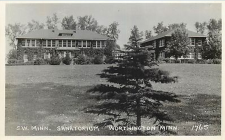Southwestern Minnesota Sanatorium
| Southwestern Minnesota Sanatorium | |
|---|---|
 | |
| Established | 1914 |
| Opened | 1917 |
| Closed | 1957 |
| Current Status | Demolished |
| Building Style | Cottage Plan |
| Location | Worthington, MN |
| Alternate Names |
|
History
The Southwestern Minnesota Sanatorium was established pursuant to a legislative act (Laws 1913 c500) that empowered boards of county commissioners to establish and maintain sanatoriums for the care and treatment of persons who were afflicted with tuberculosis. The act also allowed the cooperation of two or more counties in establishing and maintaining such a sanatorium. Any decision to build and maintain a county sanatorium was, however, subject to the advice and approval of the Commission of the Minnesota Sanatorium for Consumptives.
In 1914, the counties of Cottonwood, Jackson, Lincoln, Lyon, Murray, Nobles, Pipestone, and Rock formed an association to build, maintain, and share the services of the Southwestern Minnesota Sanatorium, which was constructed and opened in 1917 on the south shore of Lake Okabena near Worthington in Nobles County. Early in 1918, the sanatorium was forced to close due to an inadequate water supply; however, it reopened in April 1919. The Southwestern Minnesota Sanatorium Commission, which controlled the facility, was composed of members from all of the counties involved. The Nobles County Board of Commissioners appointed three members, one of whom was a physician, while the other counties’ boards of commissioners appointed another two members.
The sanatorium provided for the care and treatment of patients afflicted with pulmonary tuberculosis and also provided follow-up services for discharged patients through public health nurses in each county. Members of the sanatorium staff administered tuberculin tests and X-rays to adults, and to children through the public school system. In 1948, the counties of Blue Earth and Watonwan joined the original eight counties in the association, and Le Sueur and Redwood counties joined in 1954.
A significant decrease in the number of tuberculosis patients being admitted to the sanatorium necessitated its closing in 1957. Patients still receiving treatment at the sanatorium were transferred to other facilities in the state for tuberculosis care and treatment. The facility sold the sanatorium commission to the Southwestern Minnesota Crippled Children’s Hospital-School, Inc. (Minn. Stat. 376.54). The sanatorium commission was dissolved in October 1957. The counties of Cottonwood, Jackson, Lincoln, Lyon, and Redwood joined the Riverside Out Patient Clinic in Granite Falls, which administered tuberculosis control programs and provided out-patient diagnostic treatment.
Children's School
Eugene Wing, a businessman with a child with a disability who attended the Crippled Children’s School in Jamestown, N.D., determined that there were approximately 60 seriously handicapped children who needed education and treatment in the surrounding 12-county area. Wing eyed the buildings and grounds of the shuttered Southwestern Minnesota Sanatorium on Lake Okabena for a hospital-school.
In January 1955, Wing and representatives of the Minnesota Society for Crippled Children and Adults proposed to the sanatorium commission that the buildings be converted to a crippled children’s hospital, a proposal the commission didn’t adopt at the time. Wing then spearheaded formation of a non-profit corporation, Crippled Children’s School, Inc. When the sanatorium ultimately closed in 1957, the commission sold it to the new corporation.
Wing chaired the campaign to raise funds to renovate the old buildings. One of the fundraising brochures emphasized that there were no boarding schools for these children in Minnesota, the children needed special physical training, and for those reasons the public schools weren’t the answer. But the public schools had to be involved, for state policy required that the Worthington Public Schools provide special education services. These special education services, unfortunately, were limited to “educable” children, those with an IQ above 50, because state law didn’t require school districts to serve “trainable” children. Nevertheless, the school served many children with physical disabilities both from the surrounding counties and from throughout the state.
The Worthington Crippled Children’s School, later named the Lakeview School, operated from 1958 until 1996. In the latter years the number of children with physical disabilities decreased, in large part because of changes in federal law.